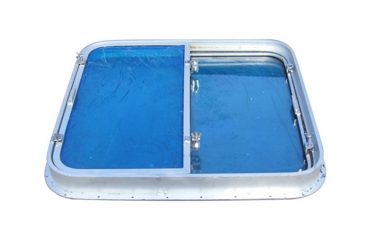Marine manhole covers are critical access components installed on ships, providing secure entry to enclosed spaces like cargo holds, tanks, engine rooms, and bilges. Unlike general ship covers, these specialized manhole-style fittings balance two core priorities: unobstructed access for maintenance, inspections, and repairs, and watertight, pressure-resistant sealing to protect against marine hazards. Engineered for the harsh conditions of sea travel, they are indispensable for vessel safety, structural integrity, and regulatory compliance. This guide explores their design features, types, safety functions, and maritime applications.
A defining characteristic of marine manhole covers is their watertight and pressure-resistant design. Ships operate in environments where water ingress can lead to catastrophic consequences—flooded compartments, cargo damage, or even vessel instability. Manhole covers address this with precision-engineered sealing systems, typically using rubber or neoprene gaskets that compress tightly when the cover is secured. Many feature bolted or dogged locking mechanisms, ensuring the cover remains fastened even in rough seas, heavy vibrations, or extreme pressure differentials (e.g., in deep tanks or below-deck compartments). The sealing design also prevents the escape of hazardous fluids like fuel or chemicals, protecting the marine environment and crew safety.
Safety is integrated into every aspect of marine manhole cover design. Beyond watertight sealing, they are built to support heavy loads—crew members, equipment, or cargo—without deformation. Most are constructed from high-strength materials like marine-grade steel, aluminum alloy, or stainless steel, offering resistance to corrosion from saltwater and chemical exposure. To prevent accidental falls, covers include non-slip surfaces (e.g., serrated edges or textured finishes) that maintain grip even in wet conditions. Many also feature safety latches or locking pins that prevent unauthorized access to restricted areas, such as fuel tanks or electrical compartments, reducing the risk of accidents or sabotage. For emergency scenarios, quick-release mechanisms allow fast access to enclosed spaces, supporting rescue operations or urgent repairs.

Marine manhole covers come in several specialized types, tailored to specific vessel compartments and operational needs. Round manhole covers are the most common, offering optimal structural strength and ease of installation—ideal for tanks, bilges, and small access points. Rectangular or square covers are used for larger openings, such as engine room access or cargo hold hatches, providing wider entry for equipment and personnel. Single-piece covers are lightweight and easy to handle, suitable for small to medium-sized openings, while multi-piece or folding covers are designed for large access points, allowing partial opening without removing the entire cover. Some covers are equipped with pressure relief valves, which release built-up gases or pressure in enclosed spaces, preventing dangerous pressure buildup and simplifying opening.
Material selection for marine manhole covers is dictated by their intended use and environmental exposure. Marine-grade steel is preferred for heavy-duty applications like cargo holds or fuel tanks, offering exceptional strength and durability. Stainless steel (316 grade) is used for corrosive environments, such as saltwater tanks or chemical storage compartments, as it resists rust and oxidation. Aluminum alloy covers are lightweight, making them ideal for upper-deck access points where weight reduction is a priority. All materials undergo rigorous testing to meet maritime standards, ensuring they can withstand extreme temperatures, saltwater immersion, and mechanical stress without failure.
Compliance with international maritime regulations is non-negotiable for marine manhole covers. They must adhere to standards set by organizations like the International Maritime Organization (IMO), SOLAS (Safety of Life at Sea), and Classification Societies (e.g., Lloyd’s Register, DNV), which outline requirements for strength, sealing, and safety features. For example, covers for fuel tanks must meet fire-resistance standards, while those for potable water tanks must be made from food-safe, non-toxic materials. Compliance ensures that manhole covers contribute to the overall seaworthiness of the vessel, reducing the risk of regulatory penalties and ensuring safe operation in global waters.
Marine manhole covers are used across all types of ships, from small fishing vessels to large cargo ships, cruise liners, and naval vessels. In cargo ships, they provide access to cargo holds for loading, unloading, and inspection, while sealing tightly to protect goods from moisture damage. Tankers rely on specialized manhole covers for fuel, chemical, or liquid cargo tanks, ensuring leak-proof containment and safe access for maintenance. Cruise ships use manhole covers for engine rooms, water tanks, and waste management systems, supporting regular maintenance while ensuring passenger safety. Naval vessels feature heavy-duty manhole covers that protect sensitive equipment and compartments, maintaining operational readiness in combat or extreme weather conditions.
Installation and maintenance are critical to maximizing the performance of marine manhole covers. Proper installation involves aligning the cover with the opening, ensuring the gasket is correctly seated, and securing the locking mechanism to achieve a watertight seal. Regular maintenance includes inspecting gaskets for wear or damage (replacing them as needed), cleaning corrosion from metal surfaces, and lubricating moving parts (e.g., hinges, latches) to ensure smooth operation. Periodic pressure testing verifies the sealing integrity, identifying leaks before they become critical. For long-term vessel storage, covers should be cleaned, dried, and secured to prevent moisture ingress and corrosion.





